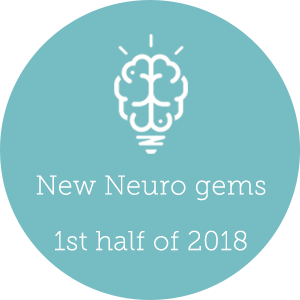5 Best NeuroMarketing Insights You Might Have Missed - First Half Of 2018
Relevant topics Archive, Strategy
Are you up to date?
Knowledge is expanding faster and faster nowadays, it’s said to double every 12 hours! This means that there’s a lot of neuromarketing facts including new tips and tricks you might have missed. The past half year, there have been articles on dominance, packaging, the prediction of Tinder dates, pricing green products, and sound/smell in stores and ads. We summarized the main findings below. Sit back in your beach chair and get ready for some new inspiration!
1. Why Dominance sells
A while ago we published an article about the Abercrombie effect, which stated that male customers’ preference for high-status products increases when encountered with a physically dominant male employee.
In addition, dominance also influences the evaluation of product faces. Drawing on evolutionary accounts of human face perception suggesting that the face width-to-height ratio can signal dominance and affect its overall evaluation. And now it’s discovered this also holds for product faces!
Like human faces, product faces with a high width-to-height ratio (i.e. a face that is more wide than high) are perceived as more dominant. However, while human faces with high width to height ratios are liked less, product faces with high width to height ratios are liked better, which is revealed by consumer preference and willingness-to-pay scores. The greater preference for the high width to height ratio-product faces is motivated by the consumers’ desire to enhance and signal their own dominant status.
2. What good packaging can do for your sales
The package is the customers’ first real-life encounter with your product. So package design is very important for targeting your customers and standing out among other products on the shelf. There are a few things your package should list: like the type of product and the brand. Besides, there is a lot of space left which you can fill with your own inspiration.
A story about your brand may benefit the impression that the product leaves on the observer. The effect of a short (rather than long) brand story was examined by a recent study. How short should the brand story be and what are the effects? Read it here! Besides a brand story, nutrition information is also something that you’ll find on every food package in the store. But how does it have to look to be informative, and what is the impact on sales?
A recent study shows that placing a nutrition icon on the front of a package (in addition to the more informative table on the back of the package) can affect product evaluations for more and less healthful products. Icons can aid consumers’ interpretations of what is healthy food, thereby benefit in product comparison contexts and thereby increases the perceived healthfulness of the product. A must-do for all healthy product marketers out there!
3. How to value environmentally responsible products
Discussion about best pricing is of all ages and there has been a lot of research on the ending of prices for a regular product. For low-priced and utilitarian products, usually odd-ending pricing is the preferable way to go. Round pricing was already proven to be preferable when buying occurs for positive emotional reasons. But much less can be found on pricing specific for green (i.e. environmentally responsible) products. Since green products are coming more and more, there’s also been some research on this topic!
Eco-friendly products are often priced higher than a conventional product because of consumers’ willingness to pay a premium price for such products. Since this fact came out, several companies have been ‘greenwashing’ their products, highlighting a few green attributes of those products to communicate it’s environmental responsibility.
But consumers are not stupid! Implicitly, they associate greenwashing as unethical and therefore, willingness to pay is significantly higher for green products compared to greenwashed products. So remember: calling your product green when it isn’t, may be too costly.
When your product truly is eco-friendly, it may be good to overthink your pricing strategy. Now it is highlighted that pricing green products and high-quality products using round-ending (compared to odd-ending) digits will increase consumers’ purchase intentions. And moreover, round pricing reduces the perception of low quality and thereby prevents a decreasing brand loyalty due to a low-priced image. So sell those real green products at a round price, and you’re in!
4. What makes a good Tinder picture?
Our research team at ST&T investigated whether dating preferences could be predicted by neuroscientific measures. Armed with an EEG headset (Click here for more information about EEG) and an eye tracker, they discovered that brain activity can be used to predict which person is swiped right and which one left. Besides, the effects of certain aspects of pictures were investigated, which you can use in your advertisements too! For example, complex pictures were shown to be liked less than simple ones. Features that make a picture easy or difficult to process can be contrast, background, composition, facial obstruction and the visibility of other people.
I hear you thinking: how to use these findings as a marketeer? Well, technically, dating is like shopping: you scan the market, pick a few products you like, compare these to each other and choose the best one. So how to make sure your product is the chosen one? Use these tips on contrast, composition and background, and make it happen! Happy swiping ;)
5. Sound and Smell: there’s more to advertising than visuals
When thinking of advertising, and shopping experience, you’ll recognize that the strongest focus lies on visual information. But what is the impact of the other senses?
Kanye West in a Chanel store or Beethoven music when shopping at Daily Paper? Naturally, we feel this does not match. Songs playing in a store can influence the buying experience, but what exactly constitutes the right music? A just-published article describes the effects of different sound frequencies on buying experience. Frequency is the natural attribute that gives music either a deep bass or rich treble. How to use the different frequencies to your advantage? Read it here!
Beside sound, smell can also play a great role in marketing. A recent study investigated not the effect of smell itself, but the effect of visually imagining a smell, thereby making the observer experience the sensation of smell, i.e. mentally recreate the sensations experienced from actual scent. They found that visually eliciting the sense of smell can negatively impact ad ratings and the likelihood to buy, especially for individuals sensitive to smell. In addition, when someone is sniffing in the commercial, the negative effect can be reversed. Thus to trigger a positive smell-associated emotion, do not forget to incorporate sniffing cues!
So this is in a short picture of what has been happening in neuromarketing research the last six months! We hope to have provided you with some new insights.
You want more neuromarketing? Or want to know how you can test your campaigns with EEG? Read here which metrics are important and how to get started to get your business neuromarketing proof!
Further Reading
-
Men Beware: The Abercrombie & Fitch Effect
Have you ever dared to walk into an Abercrombie & Fitch store? Then the memory of the many muscled six-pack wielding employees probably hasn’t vanished from your mind. The brand seems to be built around the young and fit male employees who guide the customer towards a – likely – pricey fashion investment.
Does this strategy work? Does the sight of bulging biceps, tall v-tapered physiques, and chiseled jawlines truly make the average Joe reach deeper into his wallet? Let’s find out – because science has found an answer.
-
How brand stories on packaging influence consumer behavior and purchase intent
Once upon a time, our ancestors would gather around a fire to tell stories, sharing their imaginations and lessons with others. Fast-forward to today and we are still sharing stories, but accompanied by smartphones instead of fires.
-
The Most Overlooked Psychological Factor in What Makes Advertising Music Work
Both advertisers and researchers have known for many years that music can tip the scale in an ad’s favor. The well-chosen tune can make all the difference when it comes to people attending towards the ad, developing positive attitudes and associations – and ultimately forking over their hard earned cash to buy the product.
But what exactly constitutes the right music?




